VIN decoding for Australian delivered JB74s
After pulling together a compilation of VINs for Australian delivered JB74s, I thought it would be interesting to look at build dates versus production numbers.
Note that this will not be accurate for overseas models, plus, since it isn’t based on a census of JB74s or a full register of absolutely every car and feature sold in Australia, it has to be based a bit on statistics rather than definitive numbers.
Sources
I have sourced these data from a few places:
- Sales listings when they come up in various Jimny groups or elsewhere
- Listing by wreckers (especially on ebay)
- Wreck auctions
- RAV Public Search for VINs for 2022 onwards vehicles: lets me verify build and compliance dates plus the Tare weight allows for interpreting transmissions
- Recalls notices including VIN listings: this lets me understand some of the pre-production, MY18, MY20 vehicles
- A Russian website providing breakdown of Jimny VINs and versions: not entirely accurate based on my analysis, but provides another angle on different build types.
- A survey for Australian JB74s to submit build date and VIN information for me to add to data I’ve collected.
Overseas VINs and types
I just wanted to touch on some of the other VINs, but this leans entirely on a Russian website providing breakdown of Jimny VINs and versions. I don’t have the time or energy to compile a VIN database for all gen4 Jimnys, so I’ll lean heavily on external information.
Based on the info I can get my hands onto, the following markets should follow the same series as the Australian delivered Jimnys:
- Africa
- Australia (presumably also New Zealand)
- Germany (potentially used for all of Europe)
- Hong Kong
- Israel
- Nigeria
- Pakistan
- former Soviet Union countries
- South Africa
- Taiwan
- UK
However, Europe and UK VINs might also reflect build years (separated out to make it more obvious):
| Year | VIN |
|---|---|
| 2018 | JSA GJB74V K5 100001 |
| 2019 | JSA GJB7V 7V 100001 |
| 2020 | JSA GJB74V 05 100001 |
| 2021 | JSA GJB74V N1 000001 |
| 2022 | JSA GJB74V P5 100001 |
Other VIN ranges are as follows:
LCVs in Europe/UK get vins JSAHJB74B00100001 from August 2020 onwards; possibly follow the same VIN structure as the 4 seater variants with denoting model years
South American cars look like they’re build in a different factory, with VINs commencing JS3JB74VK5100001 reflecting 2018 cars, L5 in the VIN for 2019 cars, M5 2020, N5 2021 and P5 for 2022. Suzuki have a range of plants so it’s not surprising it’s shared around.
Maruti sourced 3 door cars appear to kick off in MY2021 with VIN MA3JB74VN0100001, then change to MA3JB74DN0100001 for MY2022 and MA3JB74DP0100001 in 2023.
Progression of Australian build numbers versus build dates

The first interesting part here are the obvious breaks in build numbers, which are mentioned by other sites. This correlates with other information indicating that there’s 3 ‘versions’ of JB74s, albeit with them virtually identical. There’s little to no data to suggest there’s any meaningful changes; often there are breaks to indicate when factories re-tool or make minor tweaks to the cars but if I find any meaningful differences I’ll add that info to here.
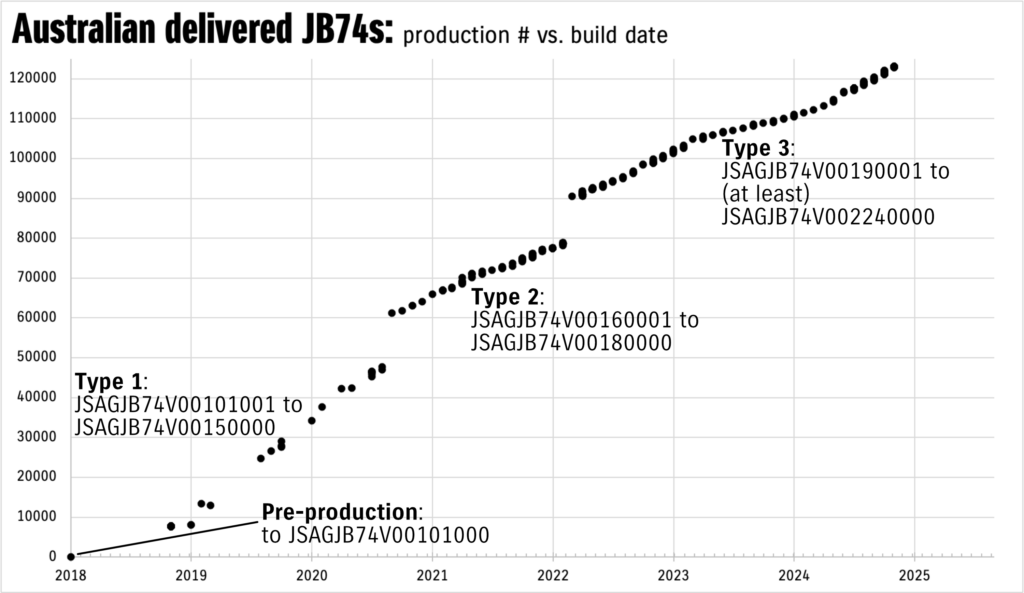
None of the breaks correlate with major feature changes in Australia either. An example of these feature changes are MY20 cars having electric folding mirrors, introducing the lite (GL) model to Australia, late MY21 and MY22 GLX cars having a different 9″ headunit (reverted back to the Bosch head unit sometime in 2023), or the change from a flatter white to a pearl white in 2023.
Don’t read too much into these differences in VINs, in other words. Although there’s a couple of large step changes in 3rd generation Jimnys (e.g. G13BB to M13A engines in 2005 along with manual to press-button transfer cases; facelift in 2012; introduction of ESP to Australia for 2015 model year) there were around 11 version over the 20 years of the model run, most of which are indistinguishable variations, so there’s no reason to expect every VIN gap/new variant is a major change.
There is a major jump in the production rate of 3 door Jimnys from mid 2024 onwards. This represents potentially a focus on these cars with production shared elsewhere e.g. more of the developing markets receiving a Maruti built JB74 instead of a Japanese built one. Interestingly it also accounts for a stockpiling of more JB74s built in the latter half of 2024 to account for the ADR compliance cutoff date of end of Feb 2025 for the current implenetation of autonomous braking in the 3 door Jimnys.
Pre-production JB74s
VINs JSAGJB74V00100001 through JSAGJB74V00101000; January 2018 to October 2018
Pre-production VINs appear to be in the range of JSAGJB74V00100001 through to JSAGJB74V00101000 i.e. build numbers 1 through 1000. This includes the earliest JB74 into Australia, which has a build number of 91 and was built January 2018. There appears to only be a single pre-production Jimny in Australia. The compliance photographs in RVCS for JB74s are a black Jimny (with silver wheels, like used on lower specification JB43s); there’s no need for these photos to have been taken in Australia.

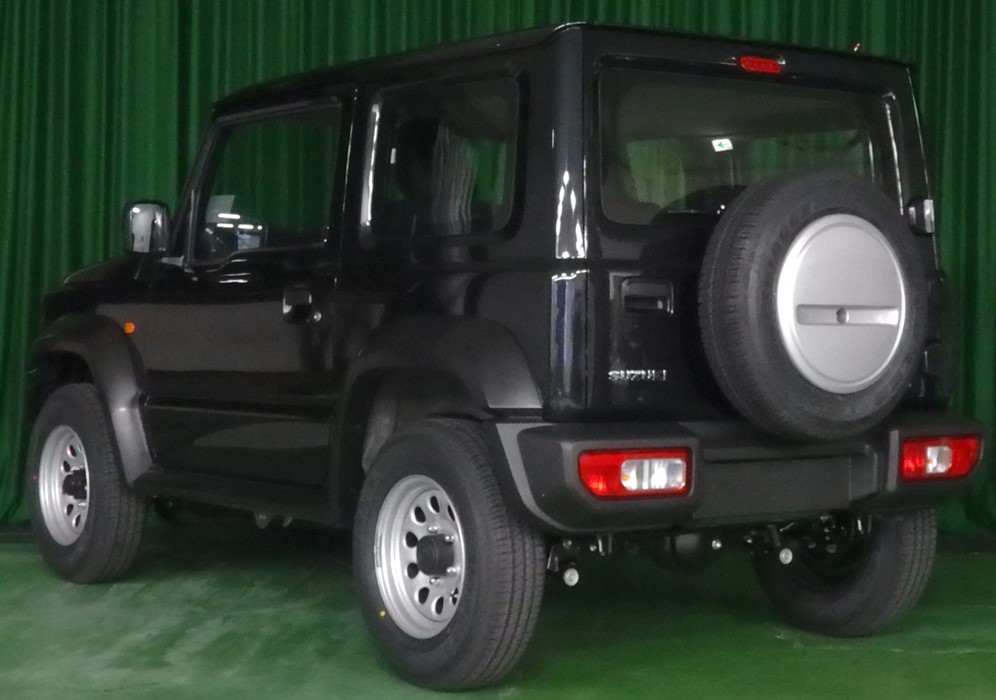
Not much more we can shed on this. Many pre-production models get used for engineering signoff, e.g. the Australian pre-production car was used for OME suspension engineering and ARB product development. Plenty of others were likely just drive around for engineering development and these are often scrapped or put into museums as they reach the end of their useful life as a product development showcase. Others will have gone to be crash tested by Euro NCAP or similar bodies, but ultimately it appears only one is in Australia and it’s owned by Suzuki Australia.
Type 1 JB74s
VINs JSAGJB74V00101001 through JSAGJB74V00150000; November 2018 to August 2020
My car is of this type (built March 2019). This is the only type for which we have complete numbers for: 3377 of these type were delivered into Australia based on VIN listings for recalls, from production numbers 7582 through to 48721 (41,139).
Type 1 JB74s in Australia begin with build 7582 (November 2018 and ends with 48721 (August 2020). We can be quite sure of this VIN range as it is provided in the breakdown of affected VINs for a couple of recalls. This isn’t to say that ~40,000 type 1 JB74s have been sold in Australia: they simply weren’t. Between November 2018 and August 2020 a total of 2562 JB74s were delivered out of these ~41,000 built in the same time period. Assuming these would need to be complianced on or before July 2020 to be sold, then production number 7582 is the first sold in Australia and production numbers in the range of ~44000 are the last of this type.
Importantly to note that this highlights the first caveat around VIN databases: not all JB74s in the build sequences depicted here go to Australia. There are other right-hand drive markets (Japan, the UK, South Africa, and New Zealand primarily) plus also European 4 seater cars that are in the same run of VINs. Other markets appear to get different VINs, as discussed above, so this isn’t a proxy for total JB74 production. It does, however give a view of the share Australia has in global Jimny markets. Around 8-10% of all Jimnys made in this sequence have been sold in Australia.
Press cars
All of the press cars used in Australia do not appear to be pre-production examples but instead are from the run of type 1 JB74s and built in November 2018, for a launch event which appeared to be early January 2019.
There was quite a variety of cars used for the launch event:

I obviously don’t have access to all of the press fleet information, but here’s what I know:
| Importer | Original plate (if known) | VIN |
|---|---|---|
| Suzuki Queensland | 267XWW | JSAGJB74V00107670 |
| Suzuki Australia | AYC178 | JSAGJB74V00107584 |
| AYC176 | JSAGJB74V00107599 | |
| AYC169 | JSAGJB74V00107680 | |
| AYC165 | JSAGJB74V00107694 | |
| AYC179 | JSAGJB74V00107696 | |
| AYC180 | JSAGJB74V00107703 | |
| AXO288 | JSAGJB74V00107713 | |
| AYC170 | JSAGJB74V00107733 | |
| AYC182 | JSAGJB74V00107751 | |
| AYC177 | JSAGJB74V00107752 | |
| AXO334 | JSAGJB74V00107765 | |
| AYC181 | JSAGJB74V00107767 |
A couple of these were used as long term test cars: AXO334 by CarSales and AYC181 with Unsealed4x4. Whichcar also long-term tested AYC165, and JBOX is effectively the Suzuki Australia super long term test car.
Unlike many typical car launches, these press cars were eventually sold into the open market due to lack of supply of vehicles in 2019. You might well have a press car yourself, e.g. if you have 1HYK743 in Western Australia, you have the car formerly known as AYC180.
Type 2 JB74s
VINs JSAGJB74V00160001 through JSAGJB74V00180000; September 2020 to February 2022
The next run of Australian delivered JB74s follow on immediate from the previous variation but there is an obvious VIN jump from different build numbers. This doesn’t appear to have any significant differences; there are just different parts catalogues for these VIN ranges. A quick look at the parts doesn’t really show any areas of suddenly different parts being used. It could even be just down to a reconfiguration of the build structure/assembly line in response to covid restrictions in Japan brought in sometime in 2020.
Type 3 JB74s
VINs JSAGJB74V00190001 through ~JSAGJB74V00224000; March 2022 to November 2024
These are probably continuing on, but the last JB74 I can seem to dredge up appears to be build 123125. This car was built November 2024, complianced mid February 2025
Presumably there will be a significant VIN break for JB74s for retooling for the revised autonomous braking ADR in force from March 2025, but without these yet complianced or in Australia there’s no further light I can shed on this (or how long the change will take to implement, either).
Derived statistics from an incomplete database of JB74 builds
Importers: Suzuki Australia versus Suzuki Queensland
There’s a couple of ways to assess this, either by looking at the split of VINs provided by Suzuki Australia and Suzuki Queensland issued recalls or by looking at the state of first registration as a proxy for delivery info.
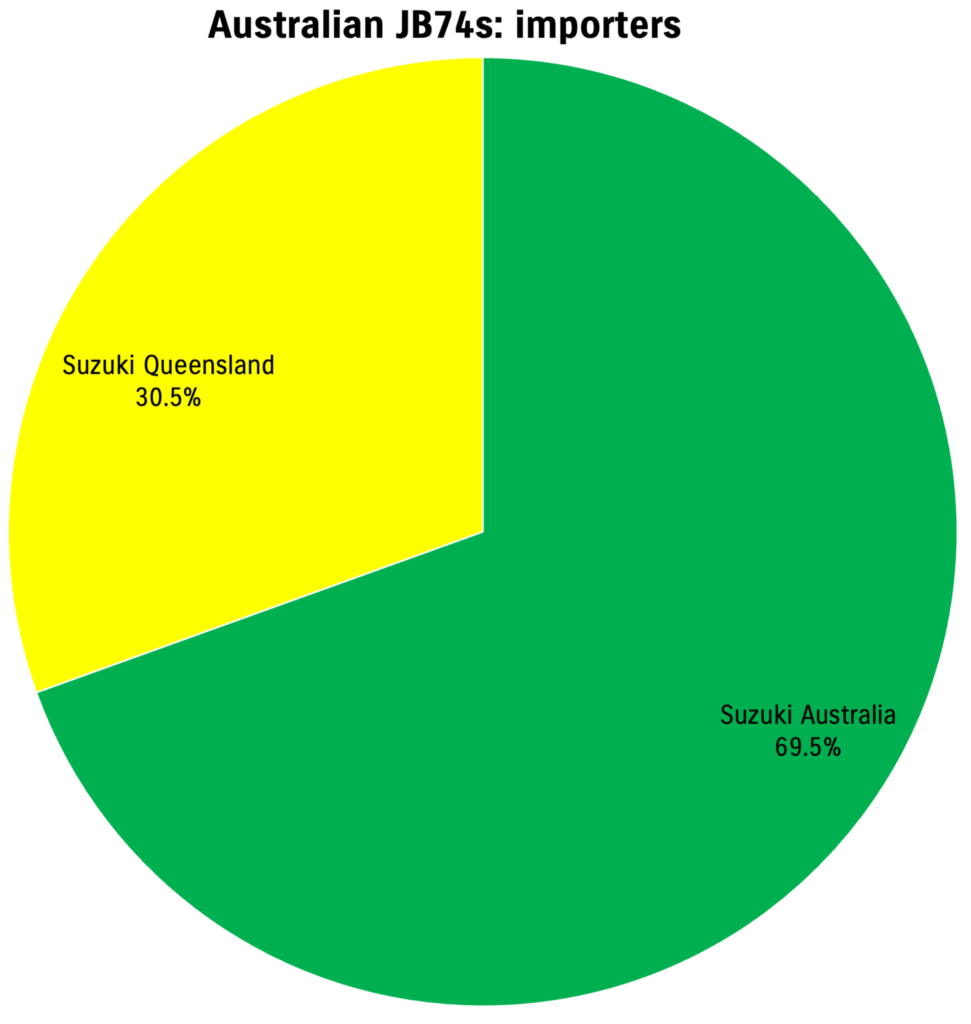
These data indicates that Suzuki Queensland accounts for a little over 30% of JB74s and Suzuki Australia just under 70%, irrespective of what recall notice you look at or based on sales data. Given the population of Queensland (~5.5M: 20% of the total) relative to the population of the rest of Australia (21.16M: 80% of the total) then one could say that relatively Queensland has ended up with more Jimnys.
Despite this, plenty of the Queensland delivered VINs have arrived in other states after their first ownership (or some dealers have sold them out of region). Correspondingly, there appears to be fewer rest of Australia VINs that are now in Queensland based on looking at sales listings and first VINs for cars where we have a full breakdown of VINs for each importer from recall notices.
Colours
One of the things I really wanted to look at with these data is the spread of colour choices and therefore what have been the most popular colours, or, alternatively, what is the share of colours delivered to Australia. Wait times vary significantly based on colour choices which could represent just fewer cars being built or shipped to Australia with these colours.
The breakdown of colour popularity in Australia from late 2018 to 2025 is quite interesting as the ‘hero colour’ of kinetic yellow is not the most popular. White, then jungle green, followed by medium grey, are the most popular colours. Black was introduced late, but is on par with blue.
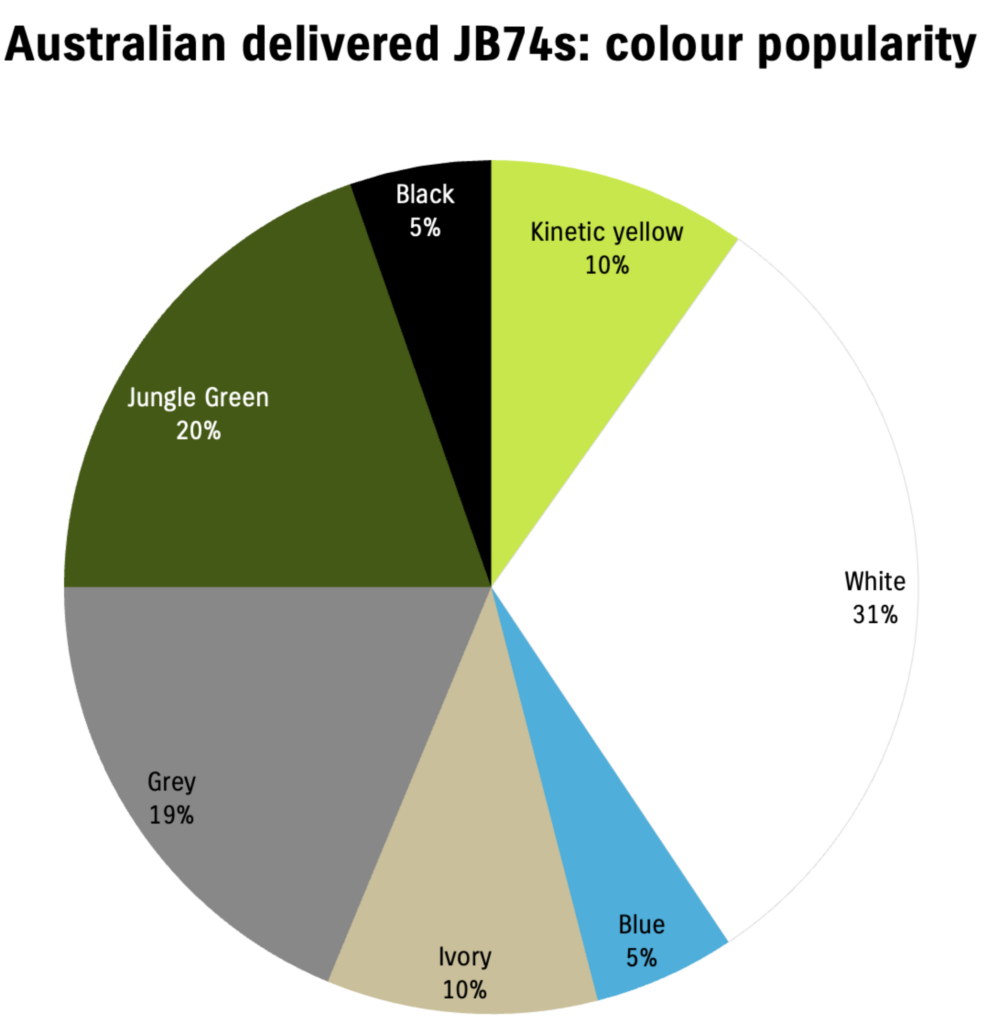
| Colour | Market share |
|---|---|
| White | 31% |
| Jungle green | 20% |
| Medium grey | 19% |
| Kinetic yellow | 10% |
| Chiffon ivory | 10% |
| Brisk blue | 5% |
| Bluish black | 5% |
There is one silver car which snuck into Queensland in the first batch of cars, but I don’t have a full record of its VIN, but otherwise it has not been offered as a colour in Australia.
Trim level
Lites are surprisingly rare. Introduced in September 2021 for the 2022 model year along with the sourcing of a different head unit for GLXs, lites are a manual only option with a few features dropped from the higher specification cars. Around 6% of all JB74s are lites, though if you just count from their introduction point it is 8% of all 3 door Jimnys.
Given lites are only manuals, this seems like a good time to look at transmission choices.
Transmission variations
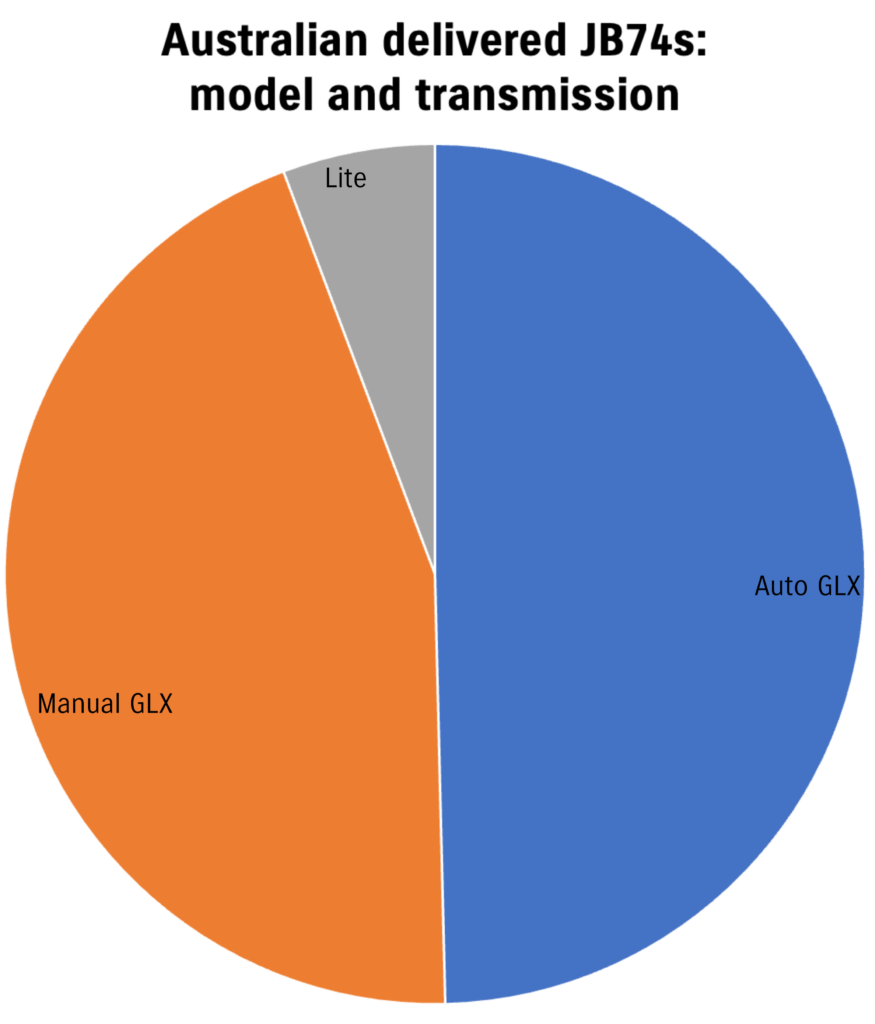
Amazingly this is close to a 50:50 split! 50.6% of Australian JB74s are manual and 49.4% are automatic. If you take out lites (i.e. only count GLX transmission splits) then automatics are marginally more popular (47.5% manual, 52.5% automatic).
This means, even accounting for trim level, manual Jimnys are much more popular than manual cars are in general in Australia. Even where manuals are offered in other cars, the vast majority of those cars sold are automatic transmission vehicles.
Up the 3 pedallers!
Time lag between build and compliance
This was part of my interest in compiling a database of build and compliance information.
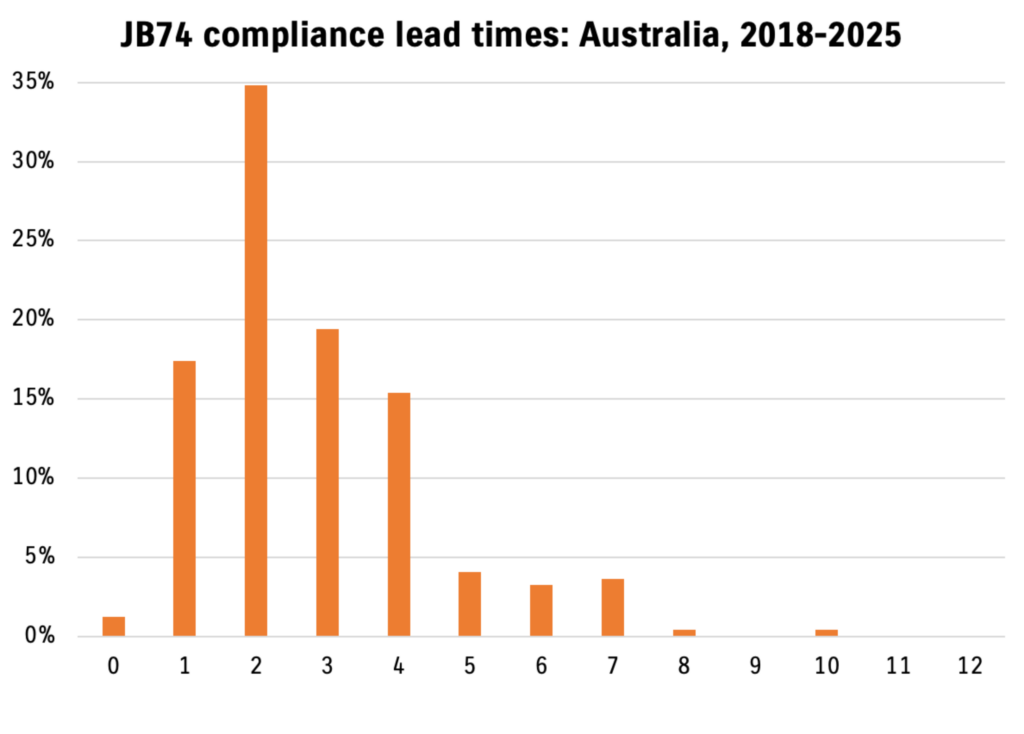
Most cars take 2 months between build and compliance, which makes sense given shipping timeframes between Japan and Australia. A few cars were built and complianced in the same month (verified against RAV entry, so not just poor data entry by car dealerships) which presumably means a car built day 1 of the month just snuck into day 30-31 of the month for compliance in Australia after 2-3 weeks of shipping time.
| Lag between build and compliance (months) | % of Australian JB74s |
|---|---|
| 0 | 1% |
| 1 | 17% |
| 2 | 35% |
| 3 | 20% |
| 4 | 15% |
| 5 | 4% |
| 6 | 3% |
| 7+ | 4% |
Compliance timeframes have also got longer over time. There’s no easy statistic to pull out, but before end of 2021 most cars were complianced in 1-2 months; it doubles to 2-4 months after this point.
Second-stage manufacturer pre-registration GVM upgrades add about 2 months to the compliance lead time, though some have taken up to a further 4 months to be processed and approved.
Second-stage manufacturer GVM upgrades
These are another thing that seems like it might be a bit less of the market than I anticipated. Around 3% of all Jimnys since the late 2020 introduction of the Ironman GVM upgrade appear to have received it as a second-stage manufacturer GVM upgrade. Tough Dog’s market penetration is smaller again, with fewer than 0.5% receiving it, and I didn’t find a single one with the TJM/XGS pre-rego GVM upgrade.
This means, out of the ~34,000 Jimnys sold to date in Australia, maybe around 1100 have received a pre-registration GVM upgrade.
Production rates
We can use these data to infer production rates (a bit), with a few visible trends obvious. Early in the JB74 life there were high production rates at the facility building Jimnys destined for Australia and similar markets, with around 2000 cars per month produced. It has then slowed down to around 1000 cars a month, but production picked up as European models were dropped in the latter half of 2024 and is close to the same production as the introduction of the model.
Yes, the following graph has some over simplification of rates, just wanted a rough idea of trends over time rather than very specific data.
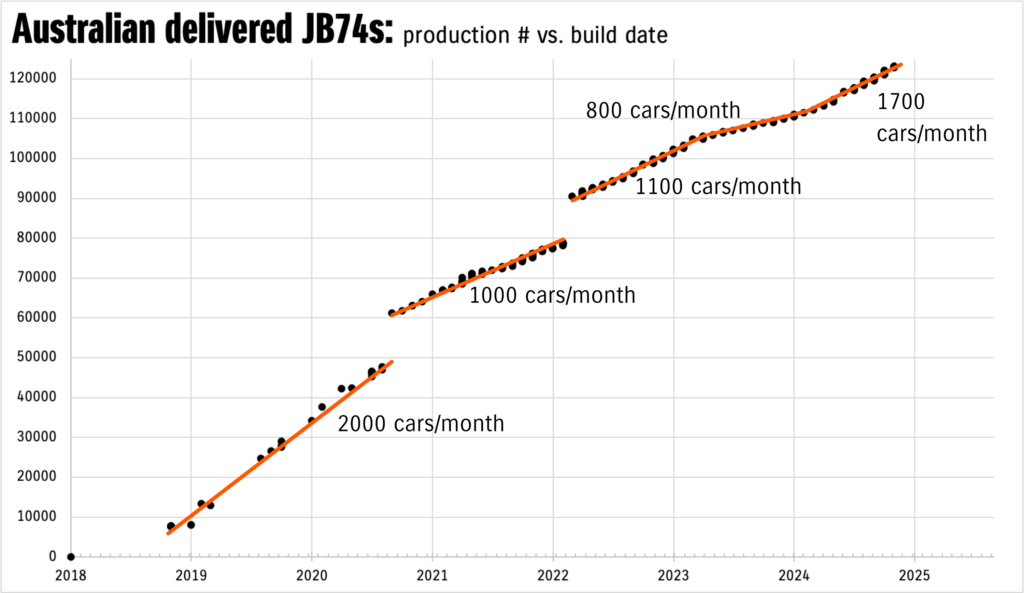
Note that all of these production rates do not take into account other production runs e.g. the decrease from mid 2020 onwards represents a shift to the production of things like European specification LCV vehicles, not a decrease in JB74 production (which has averaged at or over 100,000 units per year total since its introduction).
3 door stockpile size
As noted at the outset of looking at the Australian numbers, there’s a bump in production in 2024 for Australian destined JB74s. This allowed a stockpiling of 3 door Jimnys to account for the changes resulting in Australia’s requirements around autonomous braking.
Queensland do appear to have the latest ‘built’ batches of JB74s. The last JB74 I could find in the compliance database appeared to be build # 123125, November 2024, and was sold in June 2025. This, along with around 150 other vehicles, were complianced 12 February along with another batch of 100 vehicles in January 2025.
Suzuki Australia have batches built in October 2024, but they were complianced closer to the deadline on about the 25th of February 2025. Around 750 vehicles appear to have been brought in as part of these batches, give or take a few.
This probably means that there’s stock of about 1000 3 doors to get through the period of time prior to the introduction of revised autonomous braking systems. Looking at the progression of some of those VINs on sale sites, however, indicates they are moving fast so probably result in further supply shortages until the autonomous braking system is revised.
What about 5 door Jimnys / Jimny XL models?
In general, since I have a 3 door not a 5 door Jimny, I’ve put in a little less towards compiling databases of them. There was sufficient interest out of my VIN compilation for 3 door Jimnys that I’ve done the same for 5 doors.
Because they have been on sale for less time, and their sale time coincides with having better access to build and compliance info, the dataset is a bit more complete. Offsetting this, there’s no recall notices for me to obtain a full listing of VINs for particular year ranges so I also can’t say I have a complete listing of every car even for a particular model year.
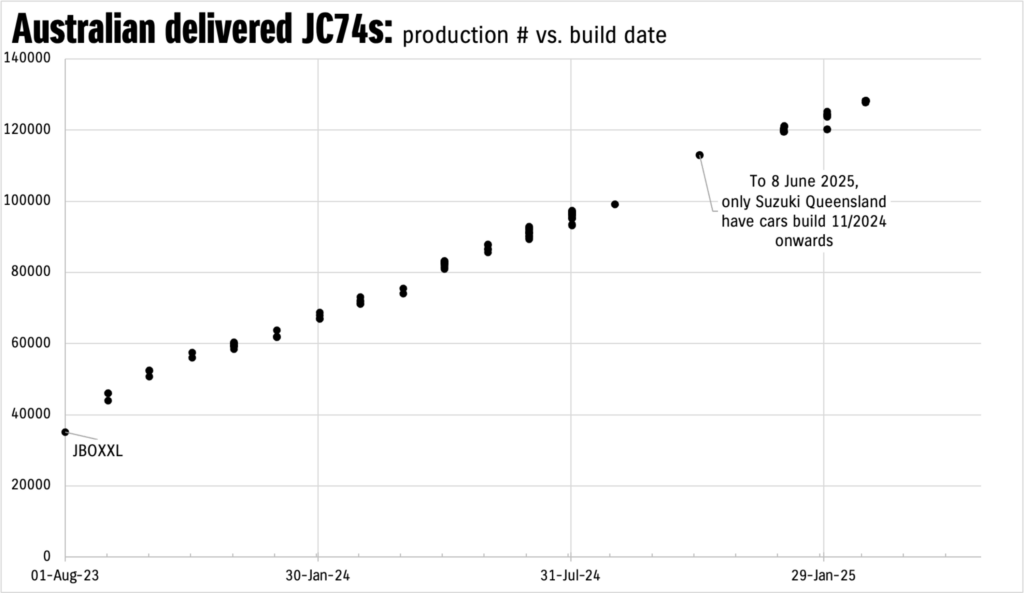
In some ways these data are simpler to understand. There’s no obvious break in production, though there is a break in Australian deliveries. This break coincides with increase in 3 door production and delivery to Australia ahead of ADR98 autonomous braking changes, so presumably building that stockpile was a priority.
Speaking of stockpiles though, 5 doors have a much longer lead time from build to compliance.
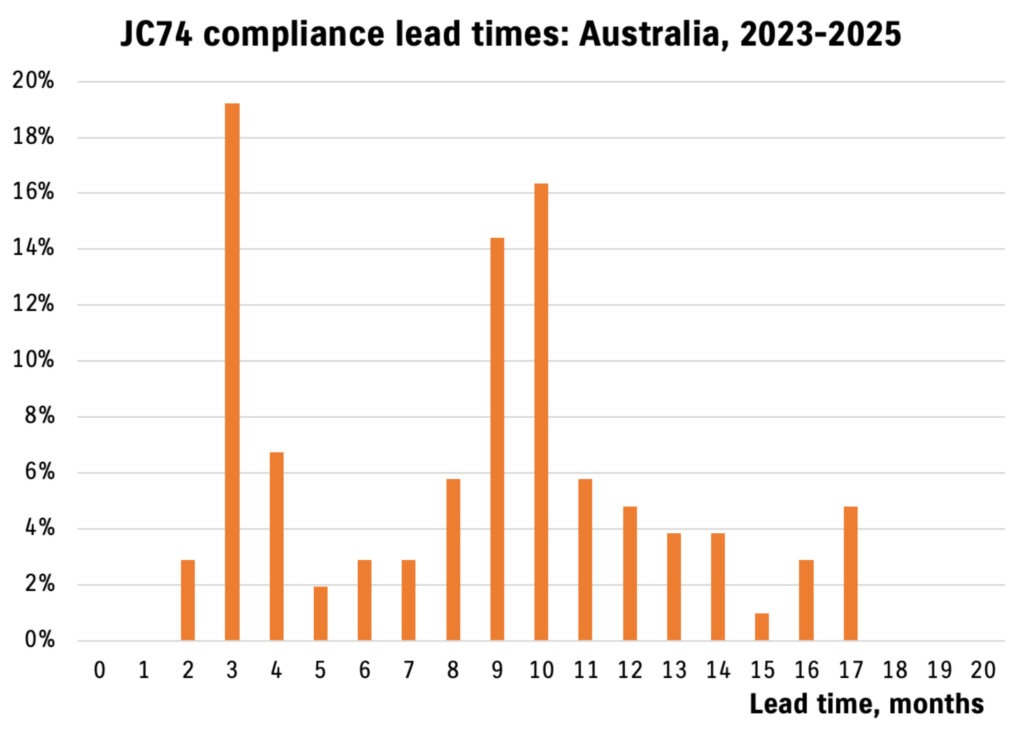
This might represent longer shipping timeframes out of India to Australia versus the more routine shipping Japan to Australia. A more likely scenario, however, is there has been a degree of stockpiling & cars are complianced as needed. There are cars, in particular manual cars, which are built all the way back in late 2023 but complianced May 2025. This means they can be sold as a 2025 car in Australia despite being a 2023 build.
This is not necessarily an issue, since there’s no changes as the cars have progressed through production, but it is something to note.
There are new 2025 build cars in Queensland: all the way through to March 2025 builds can be found in Queensland alone. The rest of Australia, where Suzuki Australia is the importer, have cars built to the latter part of 2024. Anything built November 2024 or beyond, so far, appears to be Suzuki Queensland imported only. Again this probably speaks to the building of a bit of a stockpile of 5 door cars by both importers, and then they bring in shipments only as the stockpile draws down.
Likely this will change into the future, but at the time of writing (early June 2025) this is the state of build play for 5 door Jimnys.
